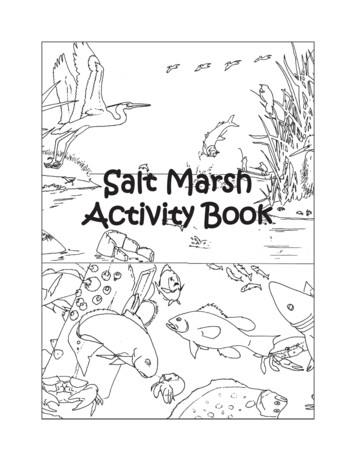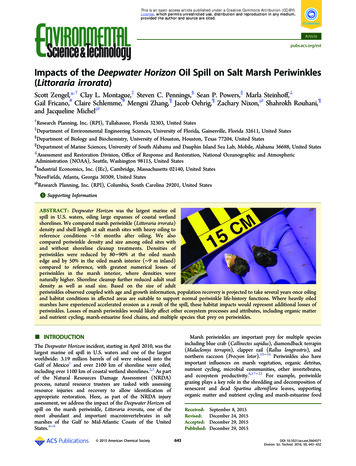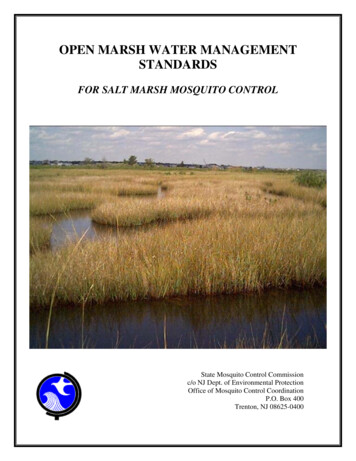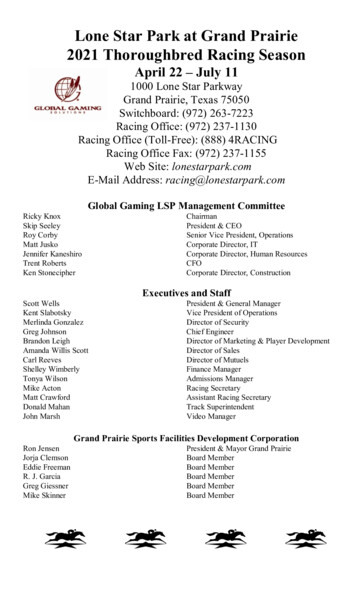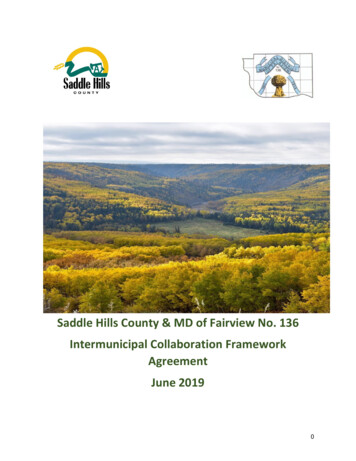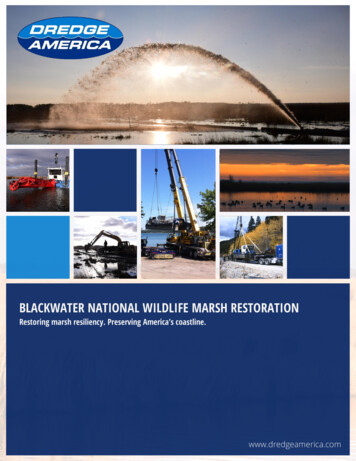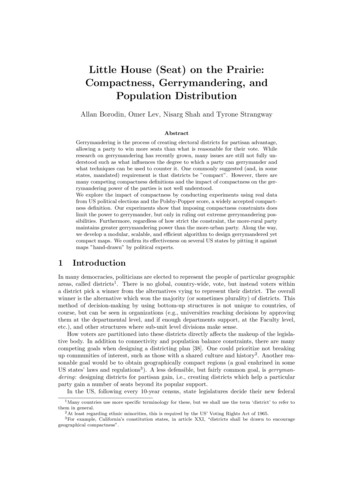
Transcription
A Prairie Marsh and its People
Copyright 2015 by Glen Suggett/Gordon GoldsboroughNo part of this work covered by the copyright hereon may be reproduced or used in any form or by anymeans – graphic, electronic or mechanical – without prior written permission of the authors.Written by: Glen Suggett, Gordon Goldsborough, Robert Jones, Winnie Pauch, Heidi Den Haan,Leo Pettipas, Shirley Christianson, Barry Bills and Cynthia Jordan.Published by the Delta Marsh History InitiativeBox 1383, Portage la Prairie, Manitoba, Canada R1N 3N9gordon.goldsborough@gmail.comVisit deltahistory.org to purchase copies of this book and to see more historical photos.Printed and bound in Canada by Friesens PrintingCover and text design: Relish New Brand ExperienceFirst Printing August 2015ISBN: 978-0-921950-51-6
TAcknowledgementshis book began with a small gathering of peoplein Mallard Lodge at the Delta Marsh FieldStation (University of Manitoba) on May 27,2001, organized by its director, Dr. GordonGoldsborough. He was researching the life of Winnipegbusinessman Donald H. Bain, who had built Mallard Lodge in theearly 1930s and thought that a book about Delta Marsh’shistory would be a great project to take on. A core group wasformed including Glen Suggett, the Wildlife Lands Managerwith the Wildlife Branch of Manitoba Conservation and WaterStewardship, Bob Jones, retired Delta Marsh Manager, Heidi DenHaan, assistant Director of the Field Station (now AssistantDirector of the Churchill Northern Studies Centre), ShirleyChristianson, Portage la Prairie resident, Maurice Blanchard, commercial fisherman, guide and businessman, Barry Bills and DenzelGamble, retired teachers, Winnie Pauch, Head of the RegionalHealth Authority (now retired), Cynthia Jordan, cottager andlong-time resident of the Oakland area, and Myrna Mackey whogrew up on a farm near Delta. What began as a project anticipated taking a year or two to complete in the end took more than adecade. Very little information was readily accessible in publishedsources, so a call went out to the local community for photographsand reminiscences. For several years Maurice Blanchard organizeda Canada Day Fish Fry at Delta Beach to promote the project andraise funds. Open houses were held to find people who had storiesto tell. There were countless individuals to interview, each with afascinating perspective on the marsh, beach, lake and surroundingfarmlands. Shirley Christianson hosted regular meetings of thehistory group in her home and for the first few years a newsletterwas published and distributed to encourage more people tocome forward with photos and stories. Sian Bumsted, SherryDangerfield, Heidi Den Haan, Bob Jones, Winnie Pauch andKerry Guenter provided research assistance and prepared background information on various topics. Leo Pettipas, retired provincial archaeologist, provided material on the early Aboriginalinhabitants and on the bombing and gunnery school at Macdonald. Dale Wrubleski provided information on his research andmonitoring work at Delta. James Burns edited the manuscript andJake MacDonald wrote the foreword for the book.Over the years a mountain of material began to amass –amazing photos from private collections that had never beenpublished before, rich oral histories, and a wealth of letters anddocuments housed in various archives around the countryand overseas. The Royal Family Archives and others provided thediaries of those who visited Delta in the late 1800s and early 1900s.The project could have gone on for another decade as the reservoir of information was rich and still largely untapped. This was apart-time venture for all involved in this work and having time todedicate to the project proved a major challenge. The material thatfollows is only the highlights of what was learned in our journey ofdiscovery. It was not feasible to include all of the stories that were toldor all the photos that were donated due to space limitations. Thesewill remain in an archive for others to use in future. In the meantime,this is some of what the Delta Marsh History Group has learnedabout this great landscape and the people who have interacted withit over the years. We hope you will find it as interesting as we have.V
Table of ContentsForeword by Jake MacDonaldIntroduction1 The First People2 People of the Plough3 Life’s a Beach4 Hunting the Wily Duck5 Hunting for Knowledge6 Droughts and Floods7 Marsh ManagementConclusionEnd NotesList of PhotographsAppendix 1 – The Delta Marsh History GroupAppendix 2 – Maps
ForewordBy Jake MacDonaldVIII DELTA
The Delta Marsh is one of the richest wetlands inNorth America. Every square centimeter of themarsh trembles and thrums with activity. Ducks,fish, herons, foxes, insects, hawks, muskrats, spiders– you’ll see hundreds and hundreds of species busily workingaround the clock at their intricate trades. The Delta Marsh is awetland Serengeti, a mini-Everglades of the north. And it’s closeto the very centre of the continent, so it’s an easy place to visit.But only a very few of the 530 million citizens of North Americahave even heard of Delta, let alone visited it. So for many readersthis book will be a handshake of welcome – an introduction to awonderful place and the people who are trying to save it.As the American poet Wallace Stevens once wrote, there aremany ways of looking at a blackbird. And there are many waysof looking at Delta Marsh, depending on one’s experience andperspective. The Métis fur trapper who tends his muskrat sets on asun-bright April morning knows a different marsh than the university student researching a thesis about the interaction betweenthose same muskrats and nesting geese. The American waterfowlhunter who spends thousands of dollars to come to Delta andshoot a few ducks knows a different marsh than the local ladyfrom St. Ambroise or St. Laurent who makes some extra incomeevery autumn, cooking his breakfast and chuckling at his jokes.And her husband sees a different marsh too, when he rises in the- 30 C darkness of a January morning to go out on the ice in histracked vehicle to pull his nets. There are thousands of peoplewho love Delta, in some way or another, and each will have his orher own story.I owe my own connection to the marsh to my father, whotook me there when I was a small boy to hunt ducks. My fatherwas a steadfast, intellectual, fair-minded sort of man who didvolunteer work for nature education and built birdhouses in hisspare time, and the fact that he also hunted birds puzzled someof his family. (When my sister and I were co-writing his obituary,she kept deleting “waterfowl hunter” from his resume and I keptputting it back.) In general, though, most waterfowl hunters aregentle characters, bird lovers and nature buffs, and my father musthave thought that an introduction to Delta Marsh would teachme something.I remember vividly those boyhood hunts – the saggy beds inthe old hunting shack, the rattle of the alarm clock at five a.m.,the clanking and smoky aroma of the old cook stove as my dadand his friends made bacon and eggs, the piles of gear, the gunsin their sheepskin cases, the crunch of frozen weeds underfootas we walked to the marsh, the growing excitement as we loadedthe rowboats and pushed away from shore, the oars creaking asIX
my dad rowed, the unseen wings whistlingpast in the darkness, and the constellationssprayed across the firmament overhead.When we reached our hunting spotmy father would set out the decoys andhaul the boat into the tall marsh grass,where we’d sit watching the eastern skyturning pink, listening to coyotes celebrating the end of night, their highpitched howls and yips erupting fromevery quadrant of the marsh. Soon it waslight enough to see the decoys bobbingin the water just a few yards downwind.My father still hadn’t moved or loaded hisgun, even though strings of ducks wereflitting past in the gloom. Finally, withoutcomment, he would feed two shells intohis Remington, noisily rack the pump,and the game was on. Soon enough, duckswould rip past, bank hard and swoop towards the decoys. The gun would go boomand a duck would hit the water. Or he’dmiss. After all these years it doesn’t matter.That was not the part that mattered. Whatmattered was being there at daybreak,having a seat at the Dawn of Creation.I eventually inherited his old pumpgun and have since spent hundreds ofsunrises in the marsh. Each outing wasa chance to experience nature in all herprimitive beauty, to reflect on family andfriends, to remember loves lost and lovesfound, and to marvel at the primevalpower of the earth to generate life. Andalthough my dad never would have put itX DELTAthat way, I suspect that’s why he wantedto take me hunting all those years ago. Hethought I would learn something that Iwouldn’t learn by staying in bed and goingto school. And like many of the peoplein this book, I believe all those “shootingtrips” to the marsh made me a differentand perhaps even a better person.Thus the many photographs of proudhunters and dead ducks in this book. Untilquite recently, no one except hunters reallycared about marshes. Most people regarded wetlands as “swamps” and worthless.(There’s that old quip, “I’ve got some niceswampland to sell you.”) By the 1930s,it was apparent that North America’swetlands were rapidly disappearing, alongwith the life they supported. And organizations like Delta Waterfowl and DucksUnlimited solicited hunters to stop thedestruction. Thanks to billions of dollarsin private donations, wetlands like theDelta Marsh are still supporting life inmyriad forms. And environmentalists, birdwatchers, farmers and other nature lovershave joined the campaign to save NorthAmerica’s shallow-water wetlands, which,as we now understand, are the most generative environments on the planet.The primary authors of this excellentbook, Dr. Gordon Goldsborough andGlen Suggett, are fine examples of thecountless dedicated people who have volunteered their time and personal resourcesto rehabilitate Delta Marsh. Like almostanyone who loves the Delta, they cantrace their devotion to personal outingson the marsh. Gordon Goldsborough firstencountered the marsh when he was ayoung university student, and as part ofhis course load was ordered to take a fieldcourse at the Delta Marsh Field Station.Like many a young student, he regardedfield trips as annoying extra work, butwhen he got to the marsh and experiencedits rough splendor he was converted. Heeventually secured a teaching position atBrandon University, but the marsh stilltugged at his heart. And in 1996, despitethe counsel of his colleagues, (“Theythought I was crazy.”) he quit histenured university job and went back tothe marsh to become the Director of theField Station.Due to budget cuts the Universityof Manitoba closed the Field Stationin 2010. Dr. Goldsborough returned tothe campus to teach botany, but says themarsh changed him forever. “There issomething magical about Delta that isdifficult to put into words. I still dreamabout it at night. I remember quiet canoepaddles through the marsh, days of toilingin the rain and the mid-summer buggyheat to collect scientific data, winter daysand snowmobile rides out into the frozenmarsh to collect water samples under theice, the many fine people I met there – Isuspect it will be in my daily thoughts forthe rest of my life.”
Glen Suggett says that his life toochanged forever when his father introduced him to the marsh. “I first learnedof Delta Marsh in the fall when I wasabout 13 and my father informed me thatwe had a shooting lodge at Delta. Thiswas like finding out that we had a familytreasure, because I had read about themarsh in outdoor magazines. I visualizeda “lodge” from an old calendar, but wasmightily disappointed upon our arrival tofind that it was a single car plywood garage on Portage Creek. I nearly froze thatnight after the fire went out in the oldQuebec heater, but the next morning inthe marsh was life changing – a gorgeoussunrise, with hundreds of ducks in the air,it was magnificent.”Suggett eventually joined theDepartment of Natural Resources in1982 and has worked at the WildlifeBranch ever since. In 2000, he and hiswife and newborn son moved to theDelta Marsh, and lived at the south endof Simpson Bay.As Glen Suggett, GordonGoldsborough, my own father, and manyothers would attest, the magic of theDelta Marsh is difficult to convey inwords. So read this book, enjoy the book,then do yourself a favor. Get some binoculars, a bird book and a canoe, and goexperience it for yourself.Left: Edward Gilroy at the OaklandCountry Club in the early 1900s.XI
Lake Manitoba lies to the left in thephotograph, with Clandeboye Bay tothe right. The marsh is protected fromthe lake by the treed beach ridge,but waters interchange though thechannel connecting Clandeboye Baywith Lake Manitoba.Introduction
Delta Marsh is one of the world’s largestfreshwater wetlands. Situated in the heart ofthe Great Plains of North America, it is one ofthe wonders of the natural world. The marsh is sovast you cannot see it in its entirety from any single place on theground. It stretches beyond the edge of the horizon and thereare few who know all of its bays, channels and ponds.This is a land of big water and big sky; a land where you cansee the weather coming. In spring, when the marsh comes to life,it is a landscape dominated by brown vegetation, blue skies, briskwinds and clear waters. In summer, green completely overtakesbrown and the wind is seldom more than a gentle breeze. Fluffywhite clouds traverse a deep blue sky at a leisurely pace. In fall,the vegetation slowly turns brown and the skies turn grey. Thewater is lashed by strong northwest winds in October and themarsh begins to freeze. For the late season wildfowler, the gentlecaress of a summer breeze is a distant memory. Bluebills, mallardsand a few hardy Canada geese linger until the marsh becomeslocked in ice. In winter, the landscape is almost universally white,with only a few brown highlights. The marsh’s slumber is regularlyinterrupted by the north wind’s roar as temperatures plunge below- 30 C and snow drifts slowly bury the cottages along the lakeshore. In March, the seemingly endless winter finally begins toretreat and once again the marsh wakens and comes alive. Springmigrants return and the cycle of life begins anew.Waterfowl, shorebirds, warblers and other birds are attracted tothe marsh in unbelievable numbers once winter releases its grip.The cottages along the lakeshore begin to re-emerge from theirsnowy tombs and people return to the beach, joining the fewhardy souls who endured the winter without respite.Great places tend to attract great people and Delta Marshwas no exception. Local people were attracted to the beach, but itwas the marsh that attracted others from around the world. Royalty, politicians, movie stars, artists, writers, astronauts, legendarysports figures, captains of industry and just plain folks learned ofits waterfowl and hunting opportunities. The pioneers of wildlife management were also attracted by Delta Marsh’s potentialfor studying waterfowl and understanding how to conserve itshabitat. However, long before the rich and famous visited Delta,Aboriginal people took advantage of its abundance of wild foods.Evidence of their use of the marsh still comes to light along thelakeshore where arrow heads, spear points and primitive tools arebriefly exposed in the sand before being reburied by wave action.Delta Marsh is a series of interconnected bays separated fromLake Manitoba by a sandy beach ridge. There are several creeksand channels that connect the marsh with the lake, allowing the1
waters of the marsh to ebb and flow withthose of the lake. Though not tidal in thenormal sense of the word, wind set-up onLake Manitoba can cause water levels torise in response to north winds and dropwhen the wind blows from the south.The origins of the marsh can be tracedback some 4,500 years when the ancientAssiniboine River flowed northward intowhat is now Lake Manitoba. The riversplit into several channels upon reachingthe lake, where it deposited sand, silt andsediment.It is believed that by some 2,500 yearsago the sediments deposited in the lakewere gradually reshaped by wind-drivencurrents to form the beach ridge, separating what is now Delta Marsh from LakeManitoba.About 2,000 years ago, the ancientAssiniboine River changed course, abandoning the route to Lake Manitoba andstriking a new path eastward to join theRed River where the City of Winnipegcontinued on page 42 DELTA
4,500 years ago3,500 years ago,500 years ago4,500ago4,500yearsyears agoOak PointLakeManitobaOak St. Ambroiselake LangruthboundarytodayLangruthSt. AmbroiseDelta BeachAssiniboine RiverOaklandSt. AmbroiseOakland3,5002,500yearsyearsago ago3,500 years agoOak PointLakeManitobaaMandharsAssiniboine RiverharsAssiniboine RiverOaklandrshMataDelSt. AmbroiseRiverta MOaklandAssiniboineDelNowNowOak PointOak PointOak PointtaDelLangruthLakeManitobaLangruthSt. AmbroiseSt. AmbroisershMaOakland OaklandLakeManitobaLangruthLangruthta MDelNowManitobaManitobaLakeManitobaLangruthSt. hLangruthLangruthSt. AmbroiseOaklandOak PointOak Point LakeLakeManitoba ManitobaLakeManitobaLangruth LangruthOaklandAssiniboine RiverNow3,500 yearsago3,500 years agoOak Point Oak PointSt. AmbroiseAssiniboine RiverAssiniboine River2,500 years ago 2,500 years agolake boundarytodaylake boundarytodayOakland2,500 years agoOak Pointharslake boundtodaySt. AmbroiseAssiniboine RiverOaklandDelta BeachAssiniboine RivergruthLakeManitobaLangruthDelta BeachAssiniboine RiveragoLakeManitobaSt. AmbroiseSt. AmbroiseOaklandLakeOakPointManitobaOak Pointlake boundarytodaylake boundarylake boundarytodaytodayDelta Beachoine RiverOak PointLakeManitobaOak PointLakeLakeManitobaManitobaLangruthLangruth3,500 years ago3,500yearsyears ago3,500agoOak Point4,500 years ago3,500 years agoharsSt. Ambroiseta MDelOaklandtaDelrshMaOaklandSt. Ambroiseh St. Ambroiseharsh rsatarsMaMleltaDDeSt. AmbroiseOaklandOaklandSt. Ambroiseta MDelOaklandarta MDelOaklanIntroduction 3
continued from page 2later developed. After the Assiniboinechanged course, the marsh lived on asa freshwater coastal wetland, fed by thewaters of the lake and localized run-offfrom the surrounding lands. Theabandoned channels of the ancientAssiniboine still convey some water tothe marsh, but their headwaters are nowonly a few kilometres from the lake.They convey a mere trickle comparedwith the former flow that once carvedthem into the landscape.The vast wetlands around the southend of Lake Manitoba became known asDelta Marsh when the Northern PacificRailway completed its spur line to thelake. Four stations were planned for therailway between Portage la Prairie andLake Manitoba, named Alpha, Beta,Gamma and Delta, following the sequence of the Greek alphabet. As eventsunfolded, there seems to have been considerable deviation from the plan. Therewere five stops instead of four and theywere named Alpha, Townline, Oakland,4 DELTACross Section of Delta MarshHuddlestone, (the surname of a nearbyhomesteader) and finally Delta, where therailway reached Lake Manitoba.From the late 1800s until the early1960s, Delta Marsh was internationallyrenowned for waterfowl hunting. However, hunters and wildlife biologists beganto notice a serious decline in the numbersof ducks using the marsh. Various effortswere made to improve the situation, butthese floundered in the early 1980s. Thetermination of the federal-provincialDelta Marsh Project in 1982 ushered inan era of precipitous decline. Emergentvegetation and submerged aquaticplants disappeared. Islands eroded awayand the once clear waters of the marshbecame murky and filled with harmfulalgae. The reasons for these adversechanges weren’t known. Some blamed iton the diversion of Assiniboine Riverwaters into Lake Manitoba. Othersthought that the marsh had becomestagnant and needed flushing. No onereally knew for sure.As the marsh entered a period ofdecline recreational preferences began tochange as well. The corporate elite weremore likely to pick up golf clubs thanshotguns. By the 1990s, severalcommercial hunting establishmentsclosed their doors for good and manyprivate hunting lodges fell into disuse.Those who came in search of thelegendary duck-hunting opportunitiesat Delta went home disappointed.The bays of the marsh that were onceso full of ducks that it would take a shoehorn to get another one in, lay empty andsilent. The beds of sago pondweed thatonce attracted sky-filling flocks of canvasbacks disappeared. The turbid waters ofthe marsh, when they did drop their sediment load on a calm summer day, revealeda lifeless bottom devoid of any vegetation.This was not the result of some toxic spill,but the relentless effects of millions ofcommon carp, an alien invasive fish species, combined with stabilized water levelsin the marsh. Without drying out period-
ically, as prairie wetlands normally do, andunder attack by legions of common carp,Delta Marsh slowly began to die.Common carp, an alien invasive fish,first appeared in the 1940s and soonbecame the dominant fish species inDelta Marsh. Research initiated in the1990s by Ducks Unlimited Canada’sInstitute for Waterfowl and WetlandsResearch, in co-operation with the DeltaMarsh Field Station (University of Manitoba), found that the spread of commoncarp into the watershed was disastrous.Imported to North America from Chinain the late 1800s to put food on the poorman’s table, common carp have greatlyincreased since their first appearance inthe marsh in the mid 1940s. The poorman, it seems, proved unwilling to eatmuddy-tasting fish, and a steady markethas never been found to encourage itsuse. For decades millions of common carpwere free to churn up the marsh bottom,uprooting pondweeds and bulrushes withreckless abandon.Increased nutrient loading, the resultof agricultural activities and residential development, may also have had an adverseeffect on the marsh. Blooms of toxic algaebecame commonplace during summer,and the increase in nitrogen and phosphorus entering the marsh has encouraged alush growth of hybrid cattail. This vigorous plant can grow in greater water depthsthan native cattail and also thrives in drierCANADAManitobaDelta MarshWinnipegPortage la PrairieIntroduction 5
(Left) Delta railway station, built in 1916, as it lookedwhile still in use in the 1930s. (Below) Clark Gablepaddles a canoe the Portage Country Club's marshwith Freeman Dalzell (1938).sites once dominated by giant reed grass(Phragmites). It can replace hardstem bulrush, the preferred nesting cover for manyover-water nesting birds, and close in areas that were formerly open water makingthe marsh less attractive to waterfowl.Though the challenges facing themarsh are daunting, they are not insurmountable. More by accident than bydesign, Lake Manitoba water levels havevaried to a greater extent in recent yearsthan they have for decades. Followingearlier measures at marsh managementthat met with mixed results, the construction of structures in the winter of2013 to prevent adult common carp fromentering the marsh have shown that thenegative trend in habitat conditions canbe reversed. Delta Marsh can be saved.Whether or not it is restored will dependon people – people like you.This is the story, really a collection ofmany stories, of where Delta Marsh camefrom, how it has changed, and how itcan be restored. It is a celebration of thepeople who enjoyed the good times and acall to action so the beach, the marsh andits wildlife can thrive again. Perhaps betterawareness and understanding will onceagain make it one of the world’s greatestwetlands.6 DELTA
Common carp, an alien invasive fish, firstappeared in the 1940s and soon became thedominant fish species in Delta Marsh.Introduction 7
Cover and text design: Relish New Brand Experience First Printing August 2015 ISBN: 978--921950-51-6. V T . Director of the Churchill Northern Studies Centre), Shirley Christianson, Portage la Prairie resident, Maurice Blanchard, com- . inhabitants and on the bombing and gunnery school at Macdon-ald. Dale Wrubleski provided information on .
